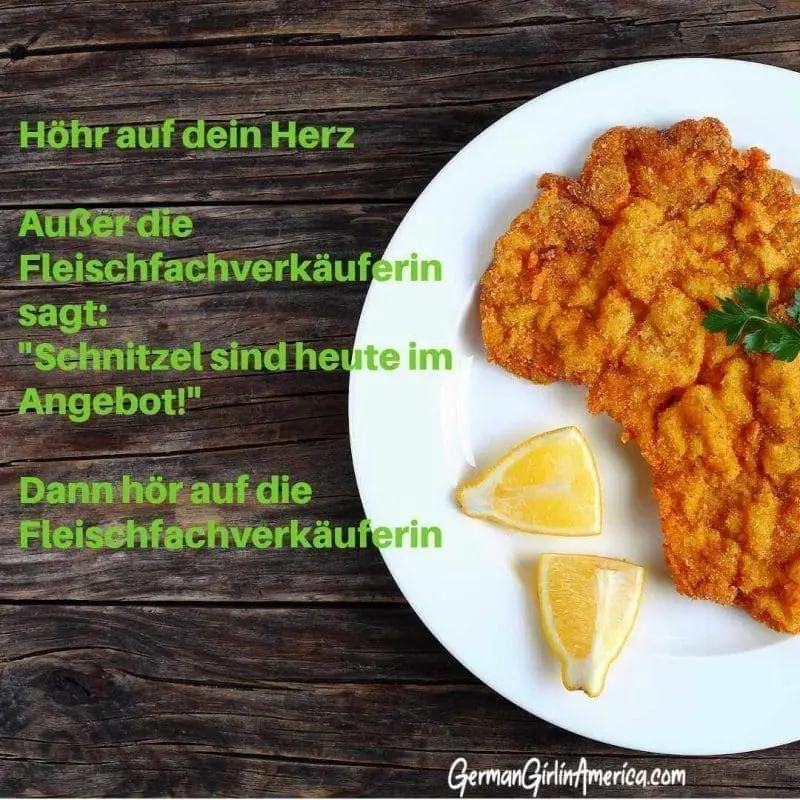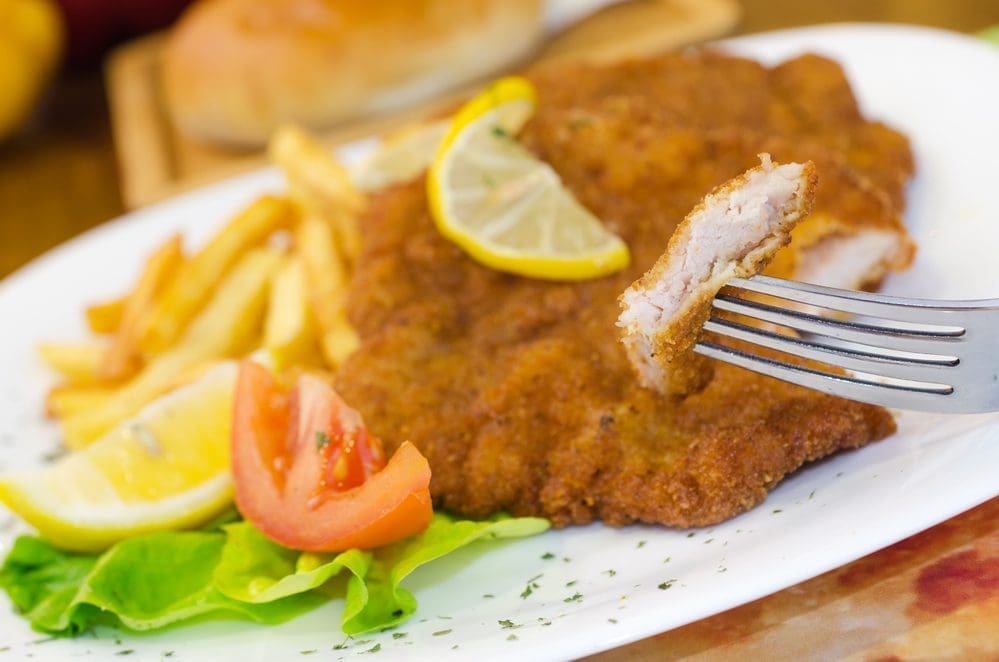On my 18th birthday I arrived in Lake Constance to vacation with my Tante and Onkel. That night they took me to dinner in the Hotel restaurant, I looked over the menu carefully since I wanted my birthday meal to be perfect. And I ordered Wiener Schnitzel. My Onkel almost fell out of his seat laughing. “That’s what you order after watching a Fußball Game with your buddies! This is supposed to be a special meal.” What can I say, to a kid who spent more time in California than Germany, Schnitzel WAS a special meal! And to me, it still is, since my mother didn’t make it at home very often. (Although in retrospect, I should have probably ordered the duck). Today, this Wiener Schnitzel Recipe is a house favorite, and high on the list of “What does everyone want for dinner?” (It falls right under “you decide” and “I don’t know”).
First, some Wiener Schnitzel history… (go ahead and scroll down to the recipe if you aren’t interested.)
September 9th is Wiener Schnitzel Day!

Wiener Schnitzel History
You can tell by the name that the Austrians have staked claim to Wiener Schnitzel. Wien = Vienna… so ‘Wiener’ means ‘of or from Vienna’. In the early 20th century laying claims to foods was all the rage, and since Austrians loved it so much… that’s what they called it. In fact, today it’s considered an Austrian Cultural Property which means it’s protected by laws, and you aren’t allowed to call a food Wiener Schnitzel if it’s anything BUT Veal, flour/egg/breadcrumbs. (Wondering about that American Hot Dog Restaurant? Well, Wienerschnitzel is one word, not two). If you are in Austria (or Germany, where the name is also protected) you know exactly what you are getting. If it’s made from pork (as it often is) it will say Wiener Schnitzel vom Schwein.
The interesting thing is… the Austrians didn’t invent the dish (and they never claimed to).
The Schnitzel Legend– Most sources trace Wiener Schnitzel back to the Austrian General Joseph Radetzky. While stationed in Lombardy, Italy sometime between 1848 and 1857, he tasted a dish called Cotoletta alla Milanese, that was so memorable, he even included a description of the meal in his report to Franz Joseph I (Emperor of Austria). Franz Joseph I loved a good meal (this is the same Franz Joseph who we thank for Kaiserschmarrn), so the Kaiser asked the General to bring the recipe home. He did, and it was a hit!
Great story. But it turns out the dish could already be found in Austrian cookbooks as early as 1831, only under a different name (remember, Wiener was added in the 20th century).
The Italians claim that the dish was carried to Austria and Germany by the Romans on their trek North to defeat the Barbarian hoards. A similar recipe is actually mentioned in a Roman cookbook from the 1st century.
My FAVORITE story comes out of the Byzantine Empire. Although Emperor Basil Ist was born a peasant, he managed, through and advantageous marriage, to gain wealth and co-Emperorship. Then he murdered the co-Emperor to become the sole emperor of Byzantium. (Nice). But like many who were born poor and then were suddenly granted wealth and power, he went a little overboard. Basil insisted that all of his food be covered in gold leaf, presumably to “make it fancy”. This got sort of expensive. So, the chef devised a dish, breaded meat cutlets fried until golden (did it fool Basil? That nugget of information is lost to history).
The truth is, a piece of meat breaded and fried isn’t that unusual in food history. Think of Japanese Tonkatsu, or Texas Chicken Fried Steak. Still, a real Wiener Schnitzel, made with tenderized breaded veal, is something special. Special enough for a birthday meal.

Listen to your heart.
Unless the lady at the meat counter tells you “Schnitzel is on sale!”
Then listen to the lady at the meat counter.
Wiener Schnitzel Recipe
A Wiener Schnitzel recipe isn’t complicated. Veal scallops are breaded and fried to golden brown. But everyone seems to be hesitant about the fat from frying (and the clean up). When the oil is heated properly, it absorbs less oil, and you are left with a crisp (and not greasy) coating. Use the one hand method while dipping into the flour/egg/crumbs, and your other hand stays clean to grab utensils or stove knobs. Serve the Schnitzel with Pommes (French Fries) and/or a green salad…. and always always… a wedge of lemon.

Wiener Schnitzel Recipe
Ingredients
- 4 Veal Cutlets approximately 5 to 6 ounces each
- ¾ cup Flour
- 2 Eggs whisked
- ¾ to 1 cup Breadcrumbs fine breadcrumbs, NOT Panko
- salt and pepper
- Frying oil- I use Safflower
Instructions
- Use a meat hammer to pound the cutlets to approximately ¼ inch thick. Season with salt and pepper.
- Close to the stove, set up a breading station with 3 soup plates. The first has the flour, the second has the eggs, and the third has the breadcrumbs.
- Pour an inch of oil into a large frying pan and heat it up. You want it to be HOT, around 350℉.
- Next to the pan, have a platter with paper towel on it to “catch” the Schnitzel.
- Dip a seasoned meat into the flour, coating both sides. Shake the excess off. Then dip in the egg, both sides, let the excess drip off. Finally, dip the Schnitzel into the breadcrumbs on both sides. DON’T press the crumbs into the meat!
- Immediately slide the Schnitzel into the oil. It should float off the bottom off the pan. Cook 2 to 3 minutes, flip, then cook 2 to 3 more minutes.
- Remove to the platter nd let rest for a minute before serving with a wedge of lemon.
Notes
Find More Great Recipes in my Easy German Cookbook
80 Classic recipes made simple for the American Kitchen. This book has the recipes your Oma made, but never wrote down…
Want to buy this book in Canada? Click HERE
Easy German Cookbook: 80 Classic Recipes Made Simple Easy German Cookbook SIGNEDGermanGirl Shop
Easy German Cookbook SIGNEDGermanGirl Shop
Other Schnitzel Dishes
But… what about all those OTHER Schnitzels you see on German menus. Basically, they aren’t Wiener Schnitzel. But they are Schnitzels… dishes made from thin slices of meat, not necessarily veal (actually, probably not veal). The name describes the sauce that comes with your Schnitzel. My favorite restaurant in Berlin- Restaurant Elefant serves 16 different Schnitzels!!
My daughter loves Schnitzel, but her student budget doesn’t always stretch for Veal. She shares her version of Chicken Schnitzel here

Here are the most common Schnitzels….
Rahm Schnitzel- Schnitzel served with a rich and creamy sauce.
Jäger Schnitzel- Schnitzel served with a creamy mushroom sauce.
Holstein Schnitzel– Schnitzel served with a caper sauce and topped with a fried egg (YUM)
Paprika Schnitzel (previously Zigeuner Schnitzel)- Schnitzel topped with bell peppers and onions.
Bavarian Schnitzel- Schnitzel coated with mustard and horseradish before it’s breaded and fried.
Zwiebel Schnitzel- Schnitzel served with roasted onions.
Gärtnerin Art– Schnitzel with carrots and peas in a cream sauce.
Schnitzel Natur- Schnitzel without breading.



